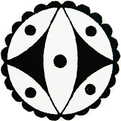1. Characteristics of the Pulse
According to the “Essentials of Pulse Diagnosis”: “It flows back and forth smoothly, like beads rolling on a plate, neither advancing nor retreating.”
In the “Binhuh Pulse Studies”: “It flows back and forth, smoothly turning, responding like beads on a finger.”
In the “Correct Eye of Pulse Diagnosis”: “The sliding pulse is smooth and flowing, resembling the shape of rolling beads, embodying the meaning of lotus dew.”
The sliding pulse is primarily understood through its shape, characterized by: smooth flow, round and slick response, resembling beads rolling on a plate. This indicates that the sliding pulse beats smoothly, with a characteristic of coming quickly and going quickly under the fingers.
The sensation of the sliding pulse is such that: at first touch, it seems the pulse is beating faster under the fingers, somewhat like counting pulses. However, upon careful observation of the pulse frequency, it becomes evident that it is not significantly different from a normal pulse, which beats four to five times between inhalation and exhalation, but it merely feels like it is beating “slightly faster”.
2. Main Symptoms
The sliding pulse is a manifestation of abundant Qi and blood. Historical pulse literature suggests that the mechanism of the sliding pulse is due to “more blood and less Qi”, contrasting sharply with the mechanism of the choppy pulse, which is characterized by “more Qi and less blood”.
Moreover, the “Huangdi Neijing” states: “A weak yet sliding pulse indicates the presence of stomach Qi.” As mentioned earlier, the kidney pulse has the characteristics of being deep and sliding, indicating that the sliding pulse often represents a normal pulse pattern rather than merely a pathological one, and it also signifies that a pulse with sliding characteristics is a manifestation of sufficient stomach Qi.
Additionally, after a meal, the pulse often exhibits sliding characteristics; and in women during pregnancy, the pulse also tends to show a sliding pattern.
If in a pathological state, the sliding pulse often indicates phlegm. As stated in the “Pulse Treatise”: “If it is sliding, then phlegm is abundant. The most sliding of all is water; phlegm is also water. When there is much water, there is phlegm; when phlegm is abundant, it is likely to be sliding.” In general, a rapid pulse indicates a heat condition, so if a sliding and rapid pulse is felt at the cun position, it often indicates phlegm-heat. The string-like pulse is associated with the liver, often indicating stagnation; thus, if a stringy and sliding pulse is felt at the cun position, it often indicates phlegm and Qi stagnation. Since the liver pulse is stringy, it governs the smooth flow of Qi, so Qi stagnation often leads to obstruction of fluid movement, resulting in phlegm accumulation; or conversely, phlegm accumulation can lead to abnormal Qi flow, presenting as a stringy and sliding pulse.
The right guan position is where the spleen and stomach pulse is assessed. Normally, the pulse in this area is full and gentle; if the right guan pulse exhibits a sliding pattern, it often indicates stagnation of heat or food retention in the stomach; or it may indicate vomiting due to food retention, which also often presents with a sliding pulse.
This article is excerpted from Liu Jianli’s “Essentials of Pulse Diagnosis”. Copyright belongs to the relevant rights holder. This public account is used solely for academic exchange. If there is any infringement, please contact the editor for removal.


